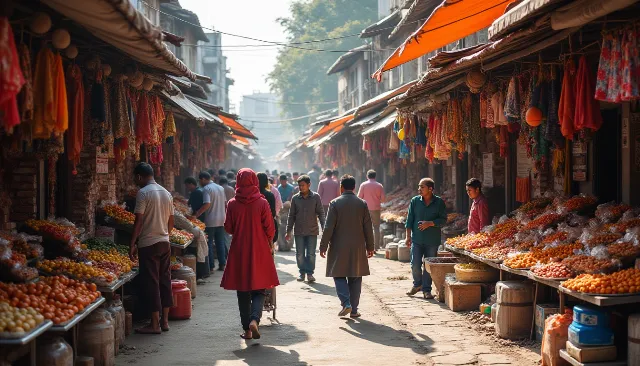Northeast Nepal is a region rich in cultural diversity, where various ethnic groups and communities come together to celebrate their unique traditions and festivals. These festivals not only mark important religious occasions but also serve as a means of preserving and showcasing the vibrant cultural heritage of the region.

This blog post will explore some of the major festivals celebrated in Northeast Nepal, their significance, and the traditions associated with them.
1.Introduction to Northeast Nepal
The Cultural Landscape
Northeast Nepal is home to a variety of ethnic groups, including the Rai, Limbu, Tamang, Sherpa, and others. Each community has its own distinct customs, languages, and belief systems. This diversity contributes to a rich tapestry of cultural practices, particularly in the realm of festivals.
Importance of Festivals
Festivals in Northeast Nepal are significant for several reasons. They provide an opportunity for communities to come together, celebrate their heritage, and reinforce social bonds. Festivals often involve rituals, music, dance, and traditional food, creating a festive atmosphere that strengthens cultural identity.
2.Major Festivals of Northeast Nepal
1.Dashain Overview
Dashain is one of the most significant festivals celebrated in Nepal, particularly in the Hindu communities of the region. It usually falls in September or October and lasts for 15 days, honoring the goddess Durga and her victory over the buffalo demon Mahishasura.
Cultural Significance
Dashain symbolizes the triumph of good over evil and is a time for family reunions and celebrations. Families gather to worship, perform rituals, and share meals, reinforcing bonds and cultural traditions.
Rituals and Celebrations
The festival includes various rituals, such as the worship of the goddess Durga, the sacrifice of goats, and the exchange of blessings. People often wear new clothes and visit their relatives, exchanging gifts and sweets. The highlight of Dashain is the Tika ceremony, where elders bless younger family members by placing a mixture of rice, yogurt, and vermillion on their foreheads.
2.Maghe Sankranti Overview
Maghe Sankranti is a festival celebrated by several communities in Northeast Nepal, marking the winter solstice and the arrival of longer days. It usually falls in January and is dedicated to the sun god, Surya.
Cultural Importance
Maghe Sankranti holds significance as it signifies the end of winter and the beginning of the harvesting season. It is a time for communities to come together and celebrate the abundance of food and prosperity.
Traditions and Celebrations
During this festival, people prepare traditional foods such as sesame seeds, molasses, and yam. They believe that consuming these foods brings health and prosperity. Many people take part in rituals by visiting temples and offering prayers to the sun god. Traditional songs and dances are performed, creating a joyful atmosphere.
3.Sonam Lhosar Overview
Sonam Lhosar is a major festival celebrated by the Tamang community in Northeast Nepal. It marks the beginning of the Tamang New Year and is observed in February or March, depending on the lunar calendar.
Cultural Significance
Lhosar is a time for the Tamang people to celebrate their heritage, culture, and community. It is a festival of renewal, marking the end of the old year and the beginning of a new one.
Celebrations and Customs
Festivities include decorating homes, preparing special dishes, and performing traditional rituals. Tamang people wear traditional attire and participate in cultural performances, including music and dance. The highlight of the celebration is the community feast, where families gather to share food and blessings.
4.Chhath Puja Overview
Chhath Puja is a festival dedicated to the sun god and is primarily celebrated by the Mithila community in Northeast Nepal. It usually takes place in October or November and lasts for four days.
Cultural Importance
Chhath Puja is significant for devotees who seek blessings for health, prosperity, and happiness. It emphasizes the importance of nature and the sun in agricultural communities.
Rituals and Offerings
The festival involves rigorous fasting, bathing in sacred rivers, and making offerings to the sun god. Devotees prepare special foods, including thekua (sweet flatbread) and fruits, which are offered during rituals. The final day includes a grand gathering where families perform prayers and rituals at riverbanks.
5.Bhanu Jayanti Overview
Bhanu Jayanti is celebrated to honor the birth anniversary of Bhanu Bhakta Acharya, the renowned poet and the first translator of the Ramayana into Nepali. This festival is celebrated on July 13 each year.
Cultural Significance
Bhanu Jayanti celebrates the rich literary heritage of Nepal and promotes the use of the Nepali language. It is a time for reflecting on the contributions of Bhanu Bhakta Acharya to Nepali literature.
Celebrations and Activities
On this day, various cultural programs and literary events are organized, including poetry recitals, storytelling, and discussions about literature. Schools and institutions also hold programs to educate students about the importance of Bhanu Bhakta’s work.
3.Unique Regional Festivals
1.Bhadra Purnima Overview
Bhadra Purnima is a full moon festival celebrated in the month of Bhadra (August or September) by various communities in Northeast Nepal. It is a time for worship and reverence toward ancestors.
Cultural Significance
The festival holds spiritual importance, as it is believed that paying homage to ancestors during this time brings blessings and prosperity to families.
Rituals and Celebrations
Devotees perform rituals at home and in temples, offering food and prayers to their ancestors. Many people also participate in community gatherings, where traditional songs and dances are performed to celebrate the occasion.
2.Indra Jatra Overview
Indra Jatra is a vibrant festival celebrated primarily in Kathmandu, but its cultural roots extend to various communities in Northeast Nepal. This festival honors Lord Indra, the god of rain, and is celebrated in September.
Cultural Importance
Indra Jatra signifies the end of the monsoon season and celebrates the harvest. It also serves to preserve the rich cultural traditions of the Newar community.
Festivities and Events
The festival features a grand procession, traditional dances, and rituals. The Kumari, the living goddess, plays a central role in the festivities. The celebration includes the raising of a ceremonial pole (Yosin) and various cultural performances, making it a colorful and lively event.
4.The Influence of Festivals on Community Life
1.Strengthening Social Bonds
Festivals play a crucial role in strengthening social ties within communities. They provide opportunities for families and friends to come together, celebrate, and share experiences.
Community Participation
The collective participation in festivals fosters a sense of belonging and unity among community members. These gatherings create lasting memories and reinforce cultural traditions.
2.Economic Impact
Festivals have a significant economic impact on local communities. They stimulate local markets, promote handicrafts, and boost tourism, benefiting artisans and small businesses.
Opportunities for Local Vendors
During festivals, local vendors sell traditional foods, crafts, and clothing, providing them with a source of income. This economic activity supports the livelihoods of many families in the region.
3.Preservation of Cultural Heritage
Festivals serve as a means of preserving and promoting cultural heritage. They celebrate traditional customs, rituals, and art forms, ensuring that they are passed down through generations.
Educational Opportunities
Festivals often include educational programs and workshops that teach younger generations about their cultural heritage. This helps instill a sense of pride in their identity and traditions.
5.Challenges Facing Festivals in Northeast Nepal
1.Climate Change
Climate change poses a significant threat to festivals, especially those dependent on seasonal changes. Erratic weather patterns can disrupt traditional celebrations and affect agricultural practices.
Adaptation Strategies
Communities are beginning to adapt their festival practices to accommodate changing environmental conditions. This includes altering agricultural practices and finding new ways to celebrate.
2.Modernization and Urbanization
Modernization and urbanization can impact traditional festivals, as younger generations may become more influenced by contemporary lifestyles and less connected to their cultural roots.
Balancing Tradition and Modernity
Finding a balance between embracing modern influences and preserving traditional practices is essential. Communities are encouraged to engage younger members in festival planning and activities to maintain cultural relevance.
3.Economic Disparities
Economic disparities can affect the participation and celebration of festivals. Some families may struggle to afford traditional foods, clothing, and participation in communal events.
Inclusive Approaches
Efforts should be made to ensure inclusivity during festivals, allowing all community members to participate regardless of economic status. Community-driven initiatives can provide support and resources to those in need.
6.The Future of Festivals in Northeast Nepal
1.Embracing Sustainable Practices
The future of festivals in Northeast Nepal may involve embracing sustainable practices that minimize environmental impact. This includes promoting eco-friendly materials and responsible tourism.
Community Engagement
Engaging local communities in sustainability initiatives can foster a sense of ownership and responsibility toward preserving their cultural heritage.
2.Leveraging Technology
Technology can play a significant role in promoting festivals and engaging wider audiences. Digital platforms can help raise awareness and attract visitors, showcasing the rich cultural traditions of the region.
Online Celebrations
During challenging times, such as the COVID-19 pandemic, online celebrations and virtual events became essential. This trend may continue, allowing festivals to reach a global audience while preserving local traditions.
3.Reviving and Reinventing Traditions
The future of festivals may involve reviving and reinventing traditional practices to keep them relevant in a changing world. Encouraging creativity and innovation within festival celebrations can attract younger generations.
7.Conclusion
The festivals of Northeast Nepal are a celebration of culture, community, and tradition. They provide opportunities for individuals to come together, reflect on their heritage, and foster social bonds. As the region navigates the challenges of modernization and climate change, preserving these rich cultural practices becomes increasingly important.
By embracing sustainable practices and engaging younger generations, the festivals of Northeast Nepal can continue to thrive, enriching the lives of both locals and visitors for years to come.
8.Frequently Asked Questions (FAQs)
1.What are the major festivals celebrated in Northeast Nepal?
Major festivals include Dashain, Maghe Sankranti, Sonam Lhosar, Chhath Puja, and Bhanu Jayanti, among others.
2.How do festivals contribute to community life?
Festivals strengthen social bonds, provide economic opportunities, and help preserve cultural heritage within communities.
3.Why is vegetarian food significant during festivals?
Vegetarian food is often prepared during festivals due to cultural and religious beliefs that emphasize non-violence and respect for life.
4.What role does music and dance play in festivals?
Music and dance are essential components of festivals, enhancing the celebratory atmosphere and allowing participants to express their cultural identity.
5.Are festivals in Northeast Nepal influenced by local customs?
Yes, festivals often incorporate local customs, rituals, and traditions, reflecting the diverse cultural landscape of the region.
6.How do modern influences affect traditional festivals?
Modern influences can lead to changes in how festivals are celebrated, but they also present opportunities for innovation and adaptation to contemporary life.
7.Can I participate in local festivals as a visitor?
Yes, many festivals welcome visitors to join in the celebrations, allowing for cultural exchange and immersion in local traditions.
8.What are some challenges facing festivals in Northeast Nepal?
Challenges include climate change, modernization, economic disparities, and the need to maintain cultural relevance in a changing world.
9.How can communities ensure inclusivity during festivals?
Communities can provide support and resources for those in need, ensuring that everyone can participate in the celebrations regardless of economic status.
10.What is the significance of preserving cultural traditions through festivals?
Preserving cultural traditions through festivals helps maintain community identity, fosters pride in heritage, and educates future generations about their roots.
Festivals in Northeast Nepal are vibrant expressions of culture and community, offering a window into the rich traditions and beliefs of the region. By celebrating and preserving these festivals, we can ensure that the cultural heritage of Northeast Nepal continues to thrive for generations to come.



